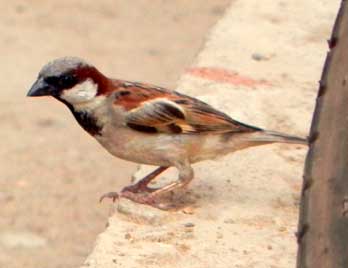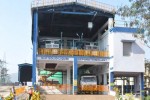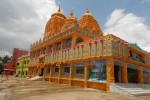Odisha Channel Bureau Kendrapara, Sep 1: The picturesque wetland and meadows within the Bhitarkanika national park has emerged yet again a congenial habitat for house sparrows.At a time when these species are fast disappearing, the sighting of these delicate birds is a positive development in flora and fauna profile of the national park.As many as 440 nesting sites of sparrows have been spotted along the mangrove-infested meadows in the core area of the national park. The identified habitation sites of these winged species are Dangmal, Dakhin Mahinsamunda, Uttar Mahinsamunda, Kalibhanjdiha, Pataparia, Durgaprasad Diha, Satabhaya and Angari forest blocks.Sparrows were earlier found to be living in villages situated on the fringes of the national park.But these birds have left the human habitation areas.Now they seem to have preferred the human-interference free forest areas of Bhitarkanika, said forest officials.Though the census of these birds are yet to be undertaken, as many as 440 nesting sites were sighted during the course of headcount of monsoon birds that has taken up earlier this month, according to Bimal Prasanna Acharya, Divisional Forest Officer (DFO), Rajnagar Mangrove (Wildlife) Forest Division. However, over a thousand house sparrows might have made Bhitarkanika their permanent home, he added. These pint-sized birds are incidentally not listed in any schedule of the Wildlife Protection Act, 1972.Over the years, they are disappearing fast and its sighting has become rare.“The human habitations thriving on the fringes of the national park have turned out to be blessing for the house sparrows.The villagers have built many straw thatched houses.Twigs from the straw come handy for sparrows’ nesting.They feed on the grains from the crop fields”, DFO Acharya told.In most other areas the grains and insects the sparrows feed on have gone out of sight due to man-made factors.The birds used to throng the countryside and the urban landscape.The increasing use of pesticides in agriculture fields mainly has spelt doom.These birds steadily perished as grain-feeding birds failed to withstand toxicity.Urbanisation and fast disappearing traditional straw-thatched houses have contributed to the shrinkage of their habitat.However, farmers in Bhitarkanika grow saline-resistant paddy.There is less use of pesticides here.Sparrows are averse to eating grains grown through application of pesticide.Thus grains here suit the food chain of these birds.
The identified habitation sites of these winged species are Dangmal, Dakhin Mahinsamunda, Uttar Mahinsamunda, Kalibhanjdiha, Pataparia, Durgaprasad Diha, Satabhaya and Angari forest blocks.Sparrows were earlier found to be living in villages situated on the fringes of the national park.But these birds have left the human habitation areas.Now they seem to have preferred the human-interference free forest areas of Bhitarkanika, said forest officials.Though the census of these birds are yet to be undertaken, as many as 440 nesting sites were sighted during the course of headcount of monsoon birds that has taken up earlier this month, according to Bimal Prasanna Acharya, Divisional Forest Officer (DFO), Rajnagar Mangrove (Wildlife) Forest Division. However, over a thousand house sparrows might have made Bhitarkanika their permanent home, he added. These pint-sized birds are incidentally not listed in any schedule of the Wildlife Protection Act, 1972.Over the years, they are disappearing fast and its sighting has become rare.“The human habitations thriving on the fringes of the national park have turned out to be blessing for the house sparrows.The villagers have built many straw thatched houses.Twigs from the straw come handy for sparrows’ nesting.They feed on the grains from the crop fields”, DFO Acharya told.In most other areas the grains and insects the sparrows feed on have gone out of sight due to man-made factors.The birds used to throng the countryside and the urban landscape.The increasing use of pesticides in agriculture fields mainly has spelt doom.These birds steadily perished as grain-feeding birds failed to withstand toxicity.Urbanisation and fast disappearing traditional straw-thatched houses have contributed to the shrinkage of their habitat.However, farmers in Bhitarkanika grow saline-resistant paddy.There is less use of pesticides here.Sparrows are averse to eating grains grown through application of pesticide.Thus grains here suit the food chain of these birds.
September 1, 2015
September 1, 2015
0 Comment
Related Articles:
- 5T Secretary reviews progress on CMO district visit grievance redressal
September 13, 2023, 11:47 am
- Patnaik announces Rs 10 lakhs each to Asian Game qualified Odisha athletes
September 13, 2023, 8:13 am
- Odisha CMO reviews grievances related to industrial development
September 12, 2023, 1:10 pm
- Odisha accelerates economic growth with approval of 9 key industrial projects
September 12, 2023, 4:02 am
- Odisha government is committed to welfare of animals: Patnaik
September 8, 2023, 4:18 pm
- Naveen Patnaik felicitates visually-challenged cricket players
September 8, 2023, 2:59 pm
- Odisha panchayat polls: Landslide victory for BJD, BJP distant second
March 1, 2022, 12:33 pm
- Hemananda Biswal: An inspiration for tribal leaders of Odisha
February 26, 2022, 5:17 am
- Hemananda Biswal passes away, to be cremated at his native place
February 26, 2022, 5:10 am
- Urban civic polls in Odisha to be held on March 24
February 25, 2022, 6:03 pm
Breaking News:
- Trump Throws Absolute Fit In Late-Night Rant For The Strangest Possible Reason
April 25, 2024, 7:18 am - Hamas official says group would lay down its weapons if a two-state solution is implemented
April 25, 2024, 4:26 am - A high-profile murder trial in Kazakhstan boosts awareness of domestic violence
April 25, 2024, 4:02 am - Woman wanted for assault inside Southern California retail shop
April 25, 2024, 3:42 am - US court sentences Chinese citizen to prison for threatening person who promoted democracy in China
April 25, 2024, 2:13 am - Secret Service agent on VP Harris' detail removed from assignment after physical fight while on duty
April 25, 2024, 2:03 am - Watch Bengal Tigers Eat a Huge Crocodile
April 25, 2024, 12:10 am - Authorities confirm 2nd victim of ex-Washington officer was 17-year-old with whom he had a baby
April 24, 2024, 10:44 pm - ‘There’s a lot of people on the waiting list’: DeSantis signs bill to give $200M boost to My Safe Florida Home program
April 24, 2024, 10:36 pm - What is the healthiest fish? This surprising No. 1 pick beat out salmon
April 24, 2024, 9:16 pm


















